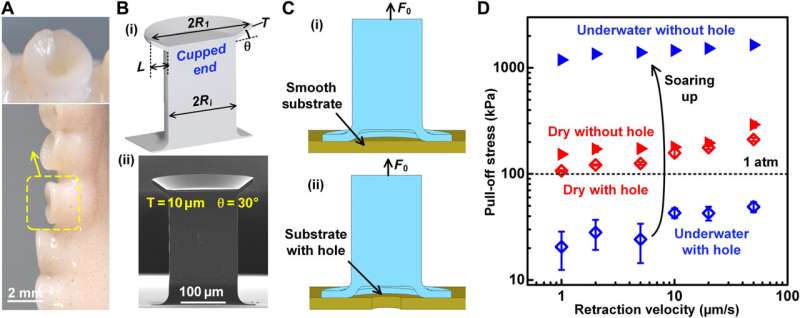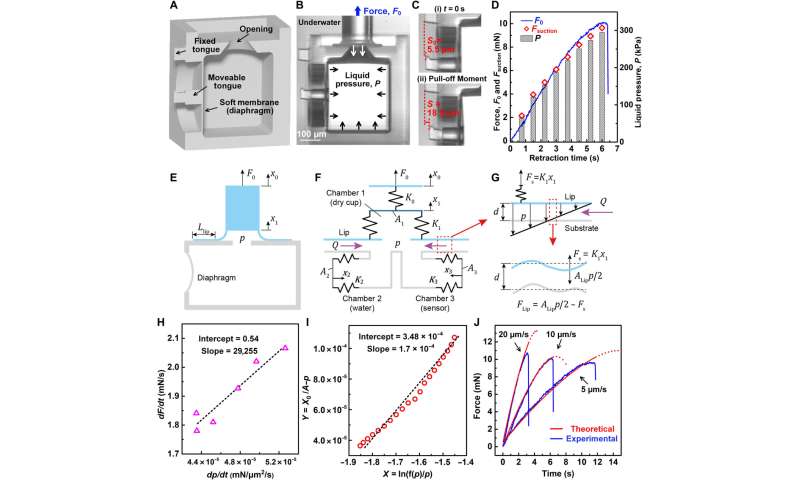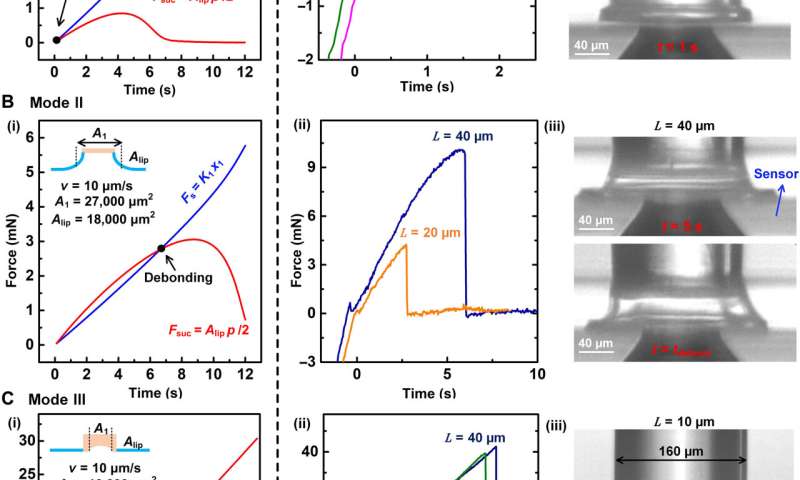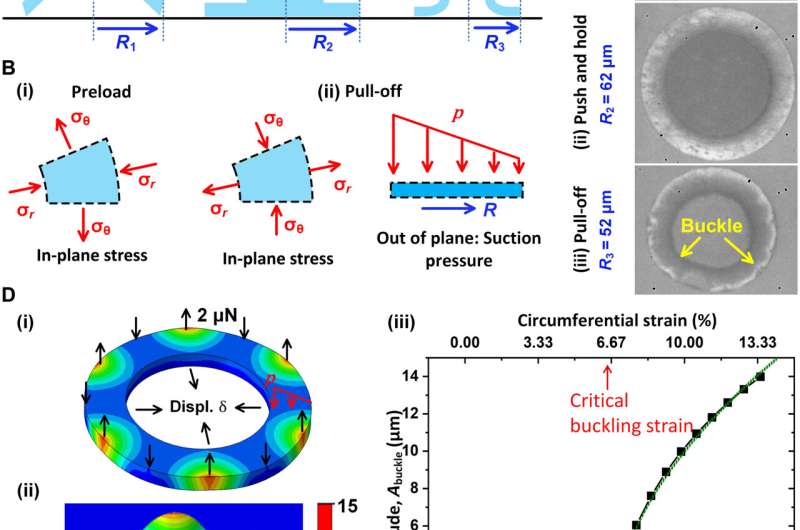March 29, 2022 feature
Water as a 'glue' for elasticity enhanced, wet attachment of biomimetic structures

In nature, octopus, clingfish and larva use soft biological cups to attach to surfaces under water. Researchers have recently developed such bioinspired cups, but their mechanisms of attachment and detachment remain elusive. A new team of scientists developed an innovative microcup engineered via two-photon lithography with integrated sensors and cameras, to reveal the detailed nature of its attachment and detachment under water. In this work, Yue Wang and a research team in new materials, and mechanical science and engineering, in Germany and the U.S., showed how elasticity-enhanced hydrodynamics improved self-healing and high suction at the cup substrate interface to convert water into "glue." The team developed a mathematical model to describe the interplay between attachment and detachment processes. Accordingly, if the process was too slow, the octopus could not attach; if the tide was too gentle for larvae, the water could not serve as a glue. The concept of water glue can therefore be used for innovative underwater transport and manufacturing strategies. The study is now published in Science Advances.
Water as glue
Water is typically not a glue since it attenuates intermolecular forces and prevents close contact between two solid bodies. Hydrophilic surfaces are generally separated by several monolayers of water, beyond typical van der Waals interactions and the average gap is expected to be higher due to surface asperities and roughness. The limitations therefore prove challenging for reversible attachment under wet conditions. In this work, Wang et al. proposed to reverse the role of water and turn it into glue, to mimic aquatic animals such as octopus, clingfish and remoras, which use suction cups for surface attachment and locomotion. Suction cups do not attach via intermolecular adhesion, but via a differential pressure, and therefore the term "attachment" can better describe such behavior. Materials scientists have formed several bioinspired suction cups for underwater applications as a powerful attachment strategy in both water and air. Wang et al. designed a miniaturized suction cup to shed light on the nature of attachment and used advanced two-photon lithography and molding at the sub-millimeter-scale to form polyurethane microcups containing a stalk and conical lip. The team developed a built-in pressure sensor to measure the pressure in the cup and used a mathematical model to create deeper understanding of attachment in a wet environment.
-

Pull-off experiments with built-in micro pressure sensor. (A) Schematic of substrate with a hole and a soft membrane acting as a pressure sensor; (B) in situ microscopy image of the suction cup and sensor; (C) membrane bending images at the start of retraction and near pull-off. (D) Attachment force F0 recorded from load cell, liquid pressure p calculated from membrane deflection, and suction force Fsuction estimated on the basis of liquid pressure p. (E) Schematic of underwater experiment with in situ pressure measurement; (F) simplified mechanical model; (G) suction pressure distribution along the contact lip and forces acting on the lip; (H) rate of change of force and pressure; (I) comparison between the theoretical model predictions and experimental data. (J) Evolution of force with time at different retraction speeds, model versus experiment. Credit: Science Advances (2022). DOI: 10.1126/sciadv.abm9341 -

Observation of three detachment modes and comparison with theoretical predictions. (A) Mode I: Cup detaches at the start of retraction. (i) Predicted evolution of spring force Fs and attachment force Fsuction for small cup lip; (ii) experimental data when cup lip L is 5 and 10 μm; (iii) in situ images of detachment when L = 10 μm. (B) Mode II: Cup detaches after suction develops: (i) predicted evolution of spring force Fs and attachment force Fsuction for large cup lip; (ii) experimental data when cup lip L is 20 and 40 μm; (iii) in situ images of detachment when L = 40 μm. (C) Mode III: Cup detaches by buckling of the lip (out of plane): (i) predicted evolution of spring force Fs and attachment force Fsuction when tested against a flat substrate; (ii) experimental data when cup lip L is 10 and 40 μm against a flat substrate; (iii) in situ images of the detachment when L = 10 μm. Credit: Science Advances (2022). DOI: 10.1126/sciadv.abm9341
The role of van der Waals forces in underwater suction cups and pressure sensors
The scientists conducted experiments in air and water to understand the role of van der Waals force in microcups. The work revealed the suction pressure to play a minor role, while van der Waals interactions dominated the attachment at the microscale under dry conditions, in air. Under water, the behavior reversed to imply negligible contributions via van der Waals forces, while hydrostatic liquid pressure contributed to the attachment. The experiments did not eliminate van der Waals forces as a potential contributor and suggested the development of an inbuilt pressure sensor to conduct further measurements of pressure. The pressure sensor contained a chamber with a diaphragm attached to the substrate via an opening so that the pressure within the cup and the chamber remained the same. The setup provided a measurement of pressure, and Wang et al. mounted a camera on the side to capture membrane deflections, while using ImageJ software to measure relative motion in the setup. The scientists proposed a mechanism of the pressure rise and developed a mathematical model for the underwater microcup to implement the proposed action. The team described a self-sealing mechanism that led to feedforward solution and cup detachment. They then investigated the detachment mechanism in depth, and noted how smaller cups made for stronger attachment, reminiscent of the "smaller is stronger" paradigm for solids.

Outlook
In this way, Yue Wang and colleagues presented detailed mechanisms of attachment by deformable microcups where water served as an adhesive glue between two surfaces such as a cup and a substrate underwater, much like with octopus and clingfish observed in nature. The team demonstrated mechanisms of attachment in a wet environment that principally differed from attachment in air. They displayed the detachment mechanisms in design maps, and based on the outcomes, they envision promising characteristics for robotics applications in micro-dimensions, underwater.
More information: Yue Wang et al, Water as a "glue": Elasticity-enhanced wet attachment of biomimetic microcup structures, Science Advances (2022). DOI: 10.1126/sciadv.abm9341
Uri Raviv et al, Fluidity of water confined to subnanometre films, Nature (2002). DOI: 10.1038/35092523
Journal information: Science Advances , Nature
Provided by Science X Network
© 2022 Science X Network




















